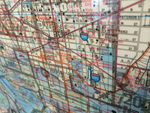This cathedral is one of the great masterpieces of Gothic art in Germany. Its unique spire is of filigree stonework; the steeple sits on an octagonal belfry, which holds a historic 4,500-kilogram (5-ton) bell dating from 1258. Although begun in 1200 in the Romanesque style, by the time it was completed in 1620, the builders had incorporated various Gothic styles.
Upon entering by the south door, you'll be in the transept facing an early-16th-century sculpture of the adoration of the Christ Child by the Magi. If you turn left into the nave, you'll see at the far end of the aisle, by the entrance to the tower, a fine 13th-century statue of the Virgin flanked by two adoring angels. The high altar has an altarpiece built between 1512 and 1516 by Hans Baldung Grien. Resting against one of the Renaissance pillars along the aisle is a carved 16th-century pulpit, with stairs winding around the curve of the column. The figures below the stairs are likenesses of the townspeople, including the sculptor.
In the aisles are 14th-century stained-glass windows. The oldest stained glass, dating from the 13th century, is in the small round windows of the south transept. Some pieces, however, have been removed to the Augustiner Museum and replaced by more recent panels.





 About our rating system
About our rating system


